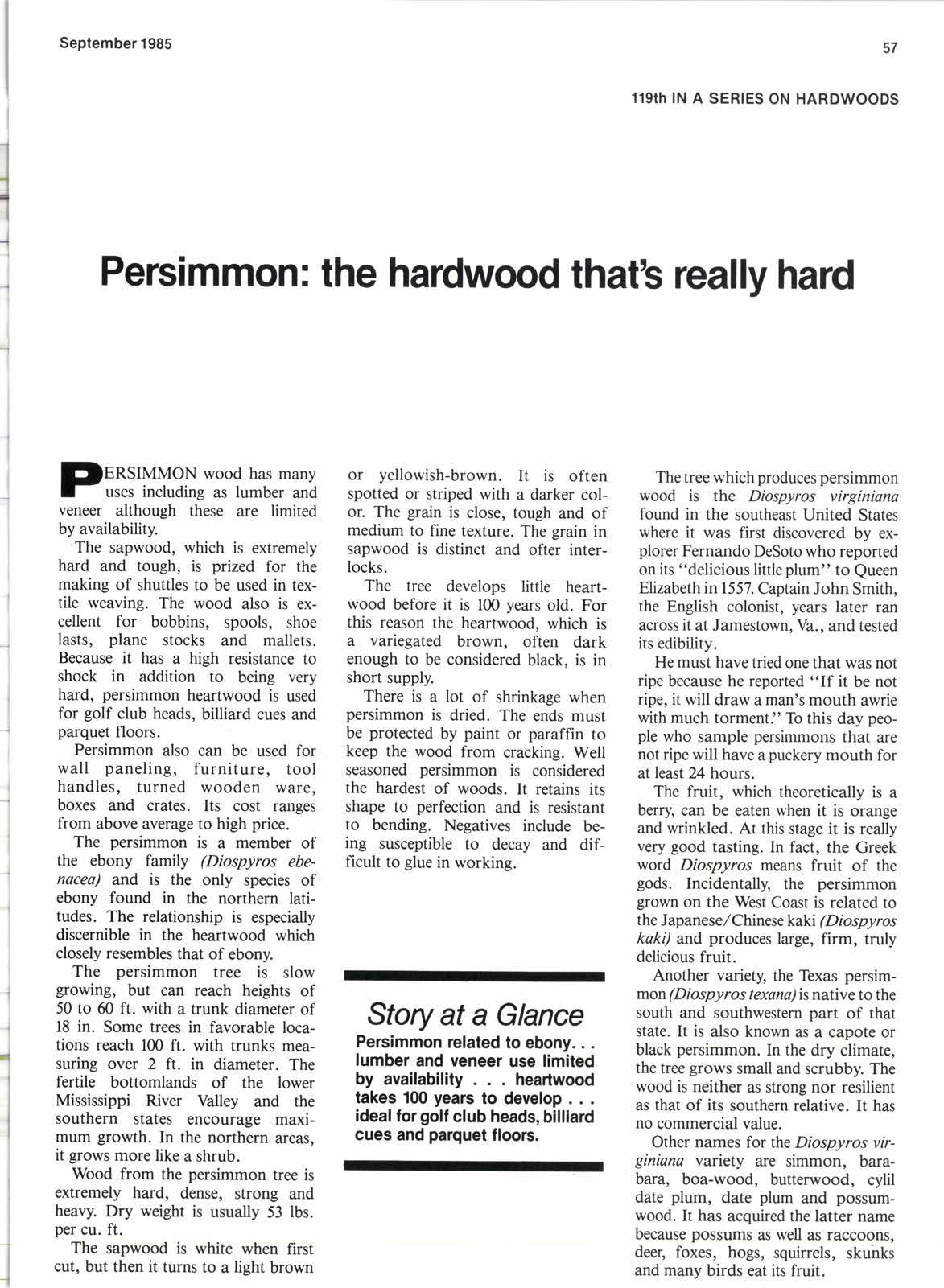
2 minute read
Persimmon: the hardwood that's really hard
ERSIMMON wood has many uses including as lumber and veneer although these are limited by availability.
The sapwood, which is extremely hard and tough, is prized for the making of shuttles to be used in textile weaving. The wood also is excellent for bobbins, spools, shoe lasts, plane stocks and mallets. Because it has a high resistance to shock in addition to being very hard, persimmon heartwood is used for golf club heads, billiard cues and parquet floors.
Persimmon also can be used for wall paneling, furniture, tool handles, turned wooden ware, boxes and crates. Its cost ranges from above average to high price.
The persimmon is a member of the ebony family (Diospyros ebenacea) and is the only species of ebony found in the northern latitudes. The relationship is especially discernible in the heartwood which closely resembles that of ebony.
The persimmon tree is slow growing, but can reach heights of 50 to 60 ft. with a trunk diameter of 18 in. Some trees in favorable locations reach 100 ft. with trunks measuring over 2 ft. in diameter. The fertile bottomlands of the lower Mississippi River Valley and the southern states encourage maximum growth. In the northern areas, it grows more like a shrub.
Wood from the persimmon tree is extremely hard, dense, strong and heavy. Dry weight is usually 53 lbs. per cu. ft.
The sapwood is white when first cut, but then it turns to a light brown or yellowish-brown. It is often spotted or striped with a darker color. The grain is close, tough and of medium to fine texture. The grain in sapwood is distinct and ofter interlocks.
The tree develops little heartwood before it is 100 years old. For this reason the heartwood, which is a variegated brown, often dark enough to be considered black, is in short supply.
There is a lot of shrinkage when persimmon is dried. The ends must be protected by paint or paraffin to keep the wood from cracking. Well seasoned persimmon is considered the hardest of woods. It retains its shape to perfection and is resistant to bending. Negatives include being susceptible to decay and difficult to glue in working.
Story at a Glance
Persimmon related to ebony. lumber and veneer use limited by availability . . . heartwood takes 100 years to develop ideal forgoll club heads, billiard cues and parquet floors.
The tree which produces persimmon wood is the Diospyros virginiana found in the southeast United States where it was first discovered by explorer Fernando DeSoto who reported on its "delicious little plum" to Queen Elizabeth in 1557. Captain John Smith, the English colonist, years later ran across it at Jamestown, Va., and tested its edibility.
He must have tried one that was not ripe because he reported "If it be not ripe, it will draw a man's mouth awrie with much torment." To this day people who sample persimmons that are not ripe will have a puckery mouth for at least 24 hours.
The fruit, which theoretically is a berry can be eaten when it is orange and wrinkled. At this stage it is really very good tasting. In fact, the Greek word Diospyros means fruit of the gods. Incidentally, the persimmon grown on the West Coast is related to the Japanese/Chinese kaki (Diospyros kaki) and produces large, firm, truly delicious fruit.
Another variety, the Texas persimmon (Diospy ros texona) is native to the south and southwestern part of that state. It is also known as a capote or black persimmon. In the dry climate, the tree grows small and scrubby. The wood is neither as strong nor resilient as that of its southern relative. It has no commercial value.
Other names for the Diospyros virginiana variety are simmon, barabara, boa-wood, butterwood, cylil date plum, date plum and possumwood. It has acquired the latter name because possums as well as raccoons, deer, foxes, hogs, squirrels, skuhks and many birds eat its fruit.










